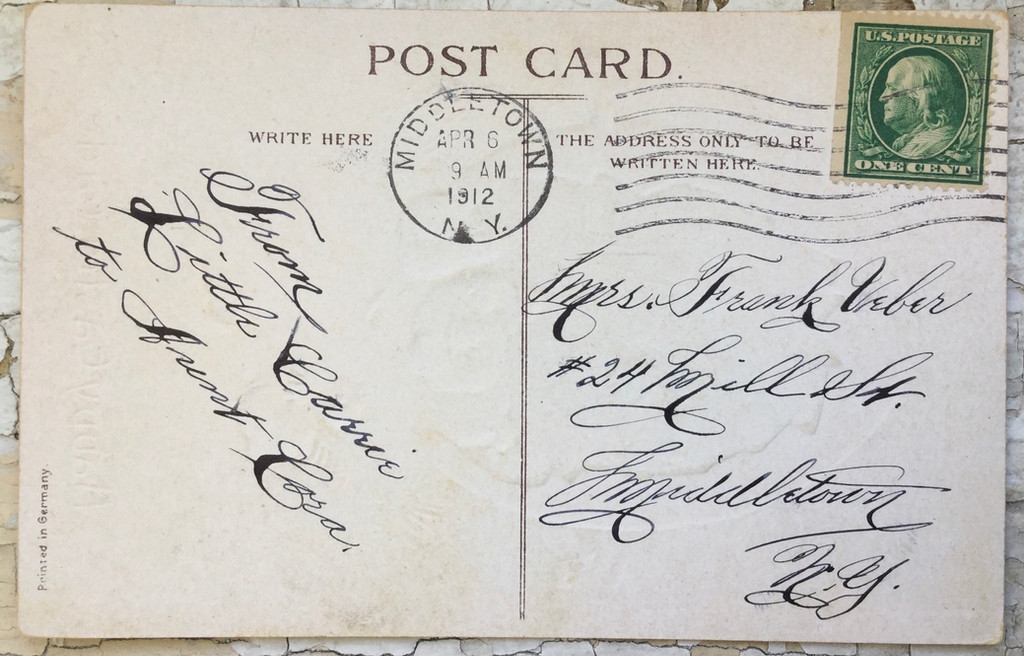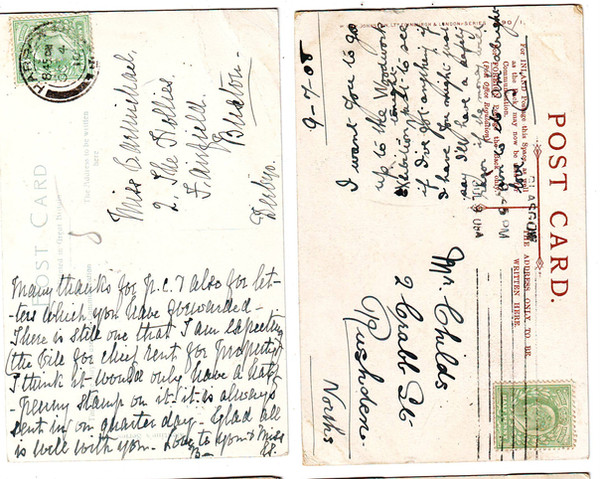HOME | DD
 Yesterdays-Paper — Antique Postcard Back 087 - Coca Cola Cursive
by
Yesterdays-Paper — Antique Postcard Back 087 - Coca Cola Cursive
by

#cursive #handwriting #handwritingfont #handwritten #historical #history #oldantique #oldfashioned #oldpaper #postcards #stationery #stock #stockimages #stocktexture #texture #texturestock #vintage #vintagestock #oldpostcard #vintageimage #postcardstock #stocktextures #vintagepaper #vintagepostcard #antiquestock #oldpapertexture #antiquevintage #old_paper #freestockimage #deltiology #old_postcard #postcardcollecting #scrapbookingstock
Published: 2020-04-10 01:31:05 +0000 UTC; Views: 1421; Favourites: 29; Downloads: 30
Redirect to original
Description
Vintage Post Card Back
Circa 1912
postmark Middletown N.Y.
Some beautiful and creative texture for your craft/art making pleasure!
For years, it was the way almost all Americans wrote. Whether in a letter, or a business proposal, or a personal diary, Spencerian Script and written communication were one and the same. Spencerian writing was so far-reaching and pervasive in American culture, it even made its way into the iconic logos of Ford Motors and Coca Cola. How did Spencerian handwriting become one of the most recognizable and important parts of American life?
A Spencerian Story It was the year 1800, and America was now several decades into its newly declared existence as an independent nation. While the American spirit was still fresh and fueling change, something significant had still been pervading its culture: the way people wrote.
At the time, the standard for all written correspondence in America was English script. A strictly uniform and consistent order of writing, it required stiff muscular and emotional restriction, allowing for almost no individual expression, and very little room for either artistic or personal style. It almost seemed symptomatic of the grievances Americans felt before declaring their independence from Great Britain.
The Birth of Spencerian WritingEnter a man named Platt Rogers Spencer. Born in a small village 70 miles north of New York City on November 7th, 1800, Spencer’s time of birth almost seemed symbolic of the changes soon to take over America.
Growing up, even as a young boy, Spencer was fascinated with the dense forests and foliage that surrounded his tiny, sparsely populated village. At the same time, he had been developing another seemingly unrelated passion: a strong fondness for writing.
Paper was difficult to obtain at the time, so Spencer looked for anything he could write on, and wrote fervently on what he found. Sand, ice, snow, the fly-leaves of his mother’s Bible, bark from the surrounding trees, he even talked his way into getting permission from a local cobbler to write on the leather in his shop.
By the time he was just 15, Spencer taught his first writing class, and for years after, he immersed himself in the study of penmanship. His early fascination with nature continued to accompany him in his journey, and slowly he began developing a style of handwriting inspired by his love of nature.
Spencer narrowed down his admiration for nature to four distinct aspects - a sense of movement, curvature, variety, and contrast. It was because of these features, he decided, that nature appeared to be beautiful wherever you looked.
He began developing the bones of what would soon become his namesake writing system, and his most memorable accomplishment. Born from the beauty of nature and the human desire for self-expression, the system developed by Spencer was nothing short of revolutionary.
A Writing Revolution
For the first time, instead of being confined to the rigid restrictions of English script - with no variance in letters and size, and no personal expression - writers were now free to explore on paper with a writing system built on motion and contrasting features. Words on paper were no longer just words: they were artistic impressions. Writing was beautiful to look at, and engaging for both the writer and the reader. Writers had a personal style they could impart in their words, that made the writing process all the more attractive. The heavy use of curves allowed ample opportunity for flourishing, opening the door to a whole other world of artistic penmanship. Writers were much more physically at ease, as it required vastly less muscle stiffness compared to English script. But perhaps the greatest accomplishment of Spencerian writing was its ability to make emotion come to life on paper.
It’s all part of what has made Spencerian so enduring, even 150 years later.
Spencer felt that if a person was able to have an alphabet that was based on those characters of nature, then you should be able to create visible language on paper that has so much personal expression, whoever reads it could understand how you felt, what you meant, how much you wanted to emphasize certain points and certain aspects of the language that you write on paper.
Spencerian script caught like wildfire in America. It resonated with so many Americans because it was not just a rejection of English tradition, but an embrace of the ideals of their nation. Spencerian allowed for expression, for freedom, for individual thought, and it took off almost immediately.
V I N T A G E S T O C K
#oldpostcard #postcardstock #deltiology #vintagestock #postcards
Vintage item from my post card and ephemera collections, free stock for yours.
Use however you like. Enjoy! 
My Gallery www.deviantart.com/yesterdays-…
Historical info from the blog of www.paperseahorse.com - a site where you can register for handwriting courses and workshops, and learn to create this beautiful fluid handwriting for yourself!
Related content
Comments: 6

👍: 0 ⏩: 0

Now that is so interesting!
I never realized that it was possible to have a concious revolution in handwriting, like a declaration to express more personality and freedom.
We used to write our essays for school or application letters in our best handwriting which was very important due to the fact that it gave the reader a sense of your skills and personality.
And then the novelty of computers started to wear off, they became part of everyday life and suddenly it was considered more professional and expected of us to type those same essays and letters.
It seems that learning how to write by hand (especially cursive) is not valuable anymore as a skill and that to me is a very sad thing.
Give me a pen in my hand any day!
👍: 0 ⏩: 0

Video : www.youtube.com/watch?v=vhmF0E…
Nature, Beauty, and Spencerian Handwriting - Michael Sull - The Paper Seahorse
Most of us who know cursive today (if you went to grammar school during the 30s, 40s, 50s, 60s, 70s or 80s) probably were taught in school by the ultra-common "Palmer Method", or Denealian.
👍: 0 ⏩: 0




























